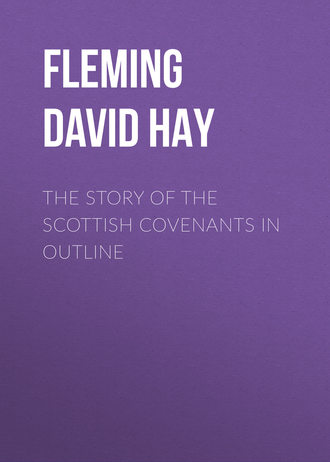 полная версия
полная версияThe Story of the Scottish Covenants in Outline
Heroic Sufferers
Not a few of the sufferers endured torments more terrible than death. Some were tortured with fire-matches, which permanently disabled their hands; some had their thumbs mercilessly squeezed in the thumbikins; some had their legs horribly bruised in the boots; and some were kept awake by watchful soldiers for nine consecutive nights. It is not surprising that nervous, sensitive men occasionally shrunk back in the day of trial. The wonder is that so many stood firm.
1
Row and the younger M’Crie are apparently in error in stating that the covenant of 1580-81 was renewed in 1596. Long before that time, however, it had been assigned a place in the Book of Laureations of Edinburgh University, that it might be subscribed by the professors and students.
2
By the five articles of Perth —
(1) Kneeling at the Lord’s Supper was approved;
(2) Ministers were to dispense that sacrament in private houses, to those suffering from infirmity or from long or deadly sickness;
(3) Ministers were to baptise children in private houses in cases of great need;
(4) Ministers were, under pain of the bishop’s censure, to catechise all children of eight years of age, and the children were to be presented to the bishop for his blessing
(5) Ministers were ordered to commemorate Christ’s birth, passion, resurrection, ascension, and the sending down of the Holy Ghost.
3
An international Protestant league was not a new idea. The Convention, which met at Edinburgh on the 20th of October 1572, had suggested that a league and confederacy should be made “with our nychtbouris of Ingland and uther cuntries reformit and professing the trew religioun,” that we and they be joined together in mutual amity and society to support each other, when time or occasion shall serve, “for mantenance of religioun and resisting of the enemies thairof.” In 1585, the Scottish Parliament (understanding that divers princes and potentates had joined themselves, “under the Pape’s auctoritie, in a maist unchristiane confederacie, aganis the trew religioun and professouris thairof, with full intent to prosecute thair ungodlie resolutioun with all severitie”) authorised the making of a Christian league with the Queen of England, to be, in matters of religion, both offensive and defensive, even against “auld freindis and confederatis.” The league, or treaty, was finally concluded by commissioners, at Berwick-on-Tweed, on the 5th of July 1586.
4
The various accounts of the slaughter are rather contradictory in their details. It may be noted, too, that – while Patrick Gordon says that fifty Irishmen were promised safe quarter and yet were killed – it was urged, in defence of the four prisoners condemned by the Scottish Parliament, that the quarter they had received was not against the orders of the Commander-in-Chief at Philiphaugh, as he only forbade the giving of quarter to the Irish. Nearly a year before (24th October 1644) the English Parliament had declared that “no quarter shall be given hereafter to any Irishman, nor to any Papist whatever born in Ireland, which shall be taken in hostility against the Parliament,” either on the sea or in England or in Wales; and ordained that they should be excepted “out of all capitulations, agreements or compositions,” and when taken should be forthwith put to death. The massacres of 1641-1642 had not been forgotten.



